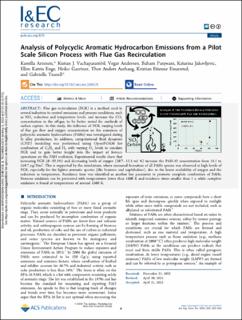| dc.contributor.author | Arnesen, Kamilla | |
| dc.contributor.author | Vachaparambil, Kurian Jomy | |
| dc.contributor.author | Vegar, Andersen | |
| dc.contributor.author | Panjwani, Balram | |
| dc.contributor.author | Jakovljevic, Katarina | |
| dc.contributor.author | Enge, Ellen Katrin | |
| dc.contributor.author | Gaertner, Heiko | |
| dc.contributor.author | Aarhaug, Thor Anders | |
| dc.contributor.author | Einarsrud, Kristian Etienne | |
| dc.contributor.author | Tranell, Maria Gabriella | |
| dc.date.accessioned | 2023-06-13T11:40:02Z | |
| dc.date.available | 2023-06-13T11:40:02Z | |
| dc.date.created | 2023-05-09T17:07:19Z | |
| dc.date.issued | 2023 | |
| dc.identifier.citation | Industrial & Engineering Chemistry Research. 2023, 62 (19), 7525-7538. | en_US |
| dc.identifier.issn | 0888-5885 | |
| dc.identifier.uri | https://hdl.handle.net/11250/3071129 | |
| dc.description.abstract | Flue gas recirculation (FGR) is a method used in several industries to control emissions and process conditions, such as NOx reduction and temperature levels, and increase the CO2 concentration in the off-gas, to be better suited for methods of carbon capture. In this study, the influence of FGR, varying levels of flue gas flow and oxygen concentration on the emissions of polycyclic aromatic hydrocarbons (PAHs) was investigated during Si alloy production. In addition, computational fluid dynamics (CFD) modeling was performed using OpenFOAM for combustion of C2H2 and H2 with varying O2 levels to simulate FGR and to gain better insight into the impact of furnace operations on the PAH evolution. Experimental results show that increasing FGR (0–82.5%) and decreasing levels of oxygen (20.7–13.3 vol %) increase the PAH-42 concentration from 14.1 to 559.7 μg/Nm3. This is supported by the simulations, where increased formation of all PAHs species was observed at high levels of FGR, especially for the lighter aromatic species (like benzene and naphthalene), due to the lower availability of oxygen and the reduction in temperature. Residence time was identified as another key parameter to promote complete combustion of PAHs. Benzene oxidation can be prevented with temperatures lower than 1000 K and residence times smaller than 1 s, while complete oxidation is found at temperatures of around 1500 K. | en_US |
| dc.language.iso | eng | en_US |
| dc.publisher | ACS | en_US |
| dc.rights | Navngivelse 4.0 Internasjonal | * |
| dc.rights.uri | http://creativecommons.org/licenses/by/4.0/deed.no | * |
| dc.title | Analysis of Polycyclic Aromatic Hydrocarbon Emissions from a Pilot Scale Silicon Process with Flue Gas Recirculation | en_US |
| dc.title.alternative | Analysis of Polycyclic Aromatic Hydrocarbon Emissions from a Pilot Scale Silicon Process with Flue Gas Recirculation | en_US |
| dc.type | Peer reviewed | en_US |
| dc.type | Journal article | en_US |
| dc.description.version | publishedVersion | en_US |
| dc.rights.holder | © 2023 The Authors. Published by American Chemical Society. | en_US |
| dc.source.pagenumber | 7525-7538 | en_US |
| dc.source.volume | 62 | en_US |
| dc.source.journal | Industrial & Engineering Chemistry Research | en_US |
| dc.source.issue | 19 | en_US |
| dc.identifier.doi | 10.1021/acs.iecr.2c04578 | |
| dc.identifier.cristin | 2146589 | |
| dc.relation.project | Norges forskningsråd: 237738 | en_US |
| cristin.ispublished | true | |
| cristin.fulltext | original | |
| cristin.qualitycode | 2 | |

